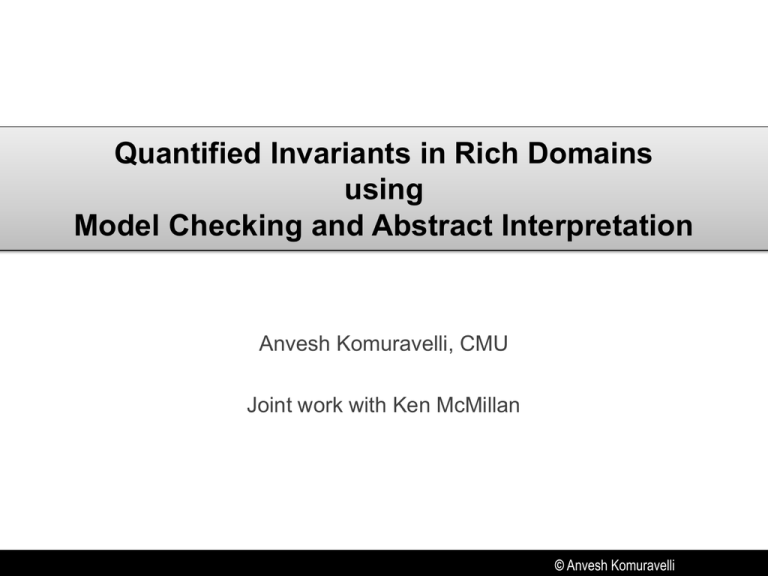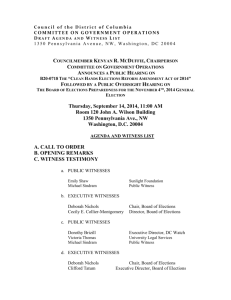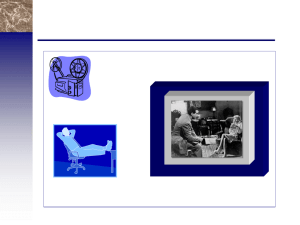slides
advertisement

Quantified Invariants in Rich Domains
using
Model Checking and Abstract Interpretation
Anvesh Komuravelli, CMU
Joint work with Ken McMillan
© Anvesh Komuravelli
The Problem
Quantified
Invariants!
Safe + Proof
Array-Manipulating
Program P
+ Assertions
Automatic analysis
for
assertion failures
Unsafe + CEX
Unknown +
Partial Proof
© Anvesh Komuravelli
1
Quantified Invariants, Typically
Specialized Abstract Domains
E.g. Segmentation abstraction,
Indexed Predicate Abstraction,
Points-to Analysis, etc.
• Restrictive
• False warnings
Unrestricted Model Checking
E.g. Interpolation-based
• Hard to find the right quantifiers
• Divergence
Rich-enough abstract domain?
© Anvesh Komuravelli
2
The abstract domain
Quantified
variables
i := 0;
while (i < n) {
//
a[i] := c;
i++;
}
assume (0 ≤ k < n)
assert (a[k] = c)
Predicate
signature
Abstract
Domain
Goal: Find a quantifier-free interpretation
of the predicates
© Anvesh Komuravelli
3
Guess-and-check doesn’t work anymore!
i := 0;
while (i < n) {
//
a[i] := c;
i++;
}
assume (0 ≤ k < n)
assert (a[k] = c)
Given a guess for P, how to check if it suffices?
FOL validity is undecidable!
Can we still use existing model checkers?
© Anvesh Komuravelli
4
Let’s look at the VCs
i := 0;
while (i < n) {
//
a[i] := c;
i++;
}
assume (0 ≤ k < n)
assert (a[k] = c)
© Anvesh Komuravelli
5
Let’s look at the VCs
Pulled to the
outermost
scope
© Anvesh Komuravelli
6
Let’s look at the VCs
Real
challenge!
Find a sufficient set
of witnesses
© Anvesh Komuravelli
7
Let’s look at the VCs
Reduces to quantifier-free
invariant generation
(use an off-the-shelf
model checker)
© Anvesh Komuravelli
8
Two Goals
Quantified
variables
i := 0;
while (i < n) {
//
a[i] := c;
i++;
}
assume (0 ≤ k < n)
assert (a[k] = c)
Predicate
signature
Abstract
Domain
Goal 1: Find a sufficient set of
witnesses for j
Goal 2: Find a quantifier-free interpretation
of the predicates
© Anvesh Komuravelli
9
A Strategy
Eager Syntactic
Pattern Matching
[BMR13]
Guess some witnesses
Check if they suffice using a model checker
Y
Found Proof
N
• Unguided instantiation
• Worst-case unbounded
• Grows exponentially with
number of quantified vars
• May choke the model checker
• No fall-back strategy
Give up!
[BMR13]: On Solving Universally Quantified Horn Clauses,
Bjorner, McMillan, Rybalchenko, SAS’13
© Anvesh Komuravelli
10
Our Strategy
Guess some witnesses
Check if they suffice using a model checker
Y
Found Proof
N CEX
Refine the guess
Constraint
on the
witness
Guess-and-check,
but of the witnesses and
not the invariant itself
© Anvesh Komuravelli
11
Obtaining Strong Constraints
Generalized Counterexamples Strong Constraints
Symbolic Counterexamples
• Number of variables = O(size)
• Constraint solving becomes harder
(easily diverging)
Ground Counterexamples
+
Abstract Interpretation
© Anvesh Komuravelli
12
Note – one witness suffices!
May not be expressible!
is equivalent to
© Anvesh Komuravelli
13
Concrete vs. Abstract
© Anvesh Komuravelli
14
Concrete vs. Abstract
© Anvesh Komuravelli
15
The algorithm
[B]
[L]
[E]
© Anvesh Komuravelli
16
The algorithm
[B]
B
P(k0,v0,i0,c0)
L
[L]
P(k1,v1,i1,c1)
L
P(k2,v2,i2,c2)
E
Instantiate
[E]
Check
© Anvesh Komuravelli
17
The algorithm
B
L
P(k0,v0,i0,c0)
Instantiate
Check
L
P(k1,v1,i1,c1)
E
P(k2,v2,i2,c2)
Analyze
© Anvesh Komuravelli
18
The algorithm
B
?
Instantiate
L
P(0,0,0,0)
P(0,0,1,0)
?
Check
L
?
P(0,0,2,0)
E
?
Analyze
© Anvesh Komuravelli
19
The algorithm
B
?
L
P(0,0,0,0)
P(0,1,0,0)
?
L
?
P(0,2,0,0)
E
?
Use k
for j
Instantiate
Check
Analyze
© Anvesh Komuravelli
20
The algorithm
[B]
[L]
[E]
Instantiate
© Anvesh Komuravelli
21
The algorithm
[B]
[L]
[E]
Instantiate
…
© Anvesh Komuravelli
22
Finding a new witness
Given
Constraint
Check
local
vars
quantified
variable
Skolem Template f
Solve for t using sampling-based approach
restrict to
linear templates
© Anvesh Komuravelli
23
Quantifier Alternation using Sampling
Quantifier
Elimination
Pick candidate tc
Y
?
N
New
candidate
tc
Y
Return tc
CEX lc
Cheap QE of integers
Add lc to existing samples S
?
Eliminate arrays
(thanks to Nikolaj for
the discussion),
N
CEX S
Source of
Divergence!
© Anvesh Komuravelli
24
Abstract Post, in practice
1. Cheap QE tricks, case-split on equalities on j, etc.
2. Under-approximate, otherwise.
Solve
Generalize models
1. Cheap QE tricks, case-split on array-index arguments, etc.
2. Under-approximate, otherwise.
Solve an SMT problem
Generalize models
© Anvesh Komuravelli
25
Experiments
Implemented “qe_array” tactic in Z3
Prototype in Python using Z3Py interface for witness generation
Automatically generated “sufficient witnesses” for small array-manipulating
programs (BMR13) – array init, find, copy, concatenate, reverse, etc.
Used GPDR engine in Z3 to solve for quantifier-free predicates
Up to two universal quantifiers per predicate
Witness was just a local variable in the VC
© Anvesh Komuravelli
26
Moving forward…
Scalability
Handle large programs (with multiple procedures)
How to pick relevant “set” of witnesses?
Can we synthesize guards to combine them into a single witness?
Implementation-wise
Cache previous AI results
Reuse bounded proofs – Proof-based Abstraction
Lazy QE – postponing to later steps?
Alternatives
Use over-approximations of reachable states
Witness may not exist – need to refine the approximation
© Anvesh Komuravelli
27
Questions?
© Anvesh Komuravelli
28






